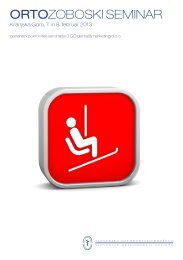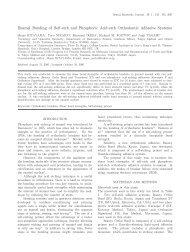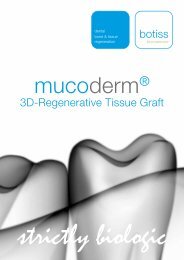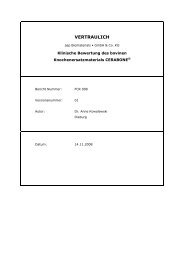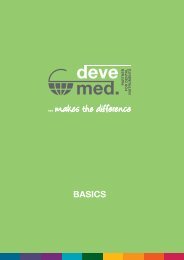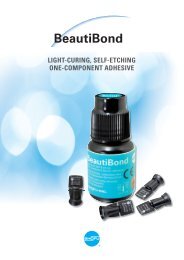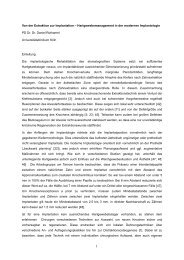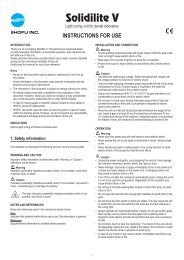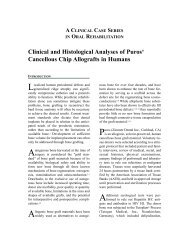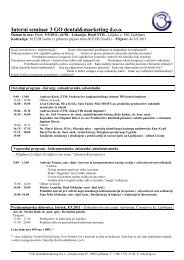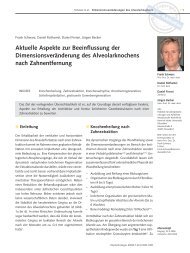Duraplasty: Our Current Experience - 3 go / dental&marketing
Duraplasty: Our Current Experience - 3 go / dental&marketing
Duraplasty: Our Current Experience - 3 go / dental&marketing
Create successful ePaper yourself
Turn your PDF publications into a flip-book with our unique Google optimized e-Paper software.
56 Surg Neurol Caroli et al<br />
2004;61:55–9<br />
period. Four of the 239 remaining patients presented<br />
complications suspected to be related to the<br />
dural implant.<br />
CASE 1<br />
A 28-year-old man was operated on for arachnoid<br />
cyst in posterior cranial fossa, and a Tutoplast pericardium<br />
implantation was performed. Immediately<br />
after operation, the patient presented fever and<br />
meningismus. A computed tomography (CT) scan<br />
showed a cerebral spinal fluid (CSF) collection in<br />
the operative field. Multiple CSF cultures failed to<br />
reveal bacterial growth. The symptoms were<br />
abated by corticosteroid administration.<br />
CASE 2<br />
A 47-year-old woman was operated on for a melanoma<br />
of the cavernous sinus, and a Tutoplast pericardium<br />
patch implantation was performed. On the<br />
50 th postoperative day she presented rhinorrhea,<br />
headache, neck stiffness, and fever. Cultures of the<br />
CSF were positive for Enterococcus faecalis. The patient<br />
was treated with antibiotic therapy, and after<br />
1 week the clinical picture regressed and 1 month<br />
later the cultures of the CSF were negative. In this<br />
case a second operation was not performed because<br />
rhinorrhea ceased spontaneously.<br />
CASE 3<br />
A 42-year-old man operated on for cerebellar hemangioblastoma<br />
underwent a Tutoplast Dura patch<br />
implantation. Two weeks later, the patient presented<br />
fever and swelling of the surgical wound.<br />
Cultures of the purulent material taken from the<br />
swelling and CSF cultures revealed Staphilococcus<br />
aureus. The patient was reoperated; during the second<br />
operation we found subcutaneous and submuscular<br />
purulent material. Tutoplast Dura was reabsorbed<br />
and cerebellar surface was unaltered. The<br />
operative field was meticulously cleaned with hydrogen<br />
peroxide and local antibiotics. A second<br />
Tutoplast Dura patch was implanted. Daily wound<br />
medications were administered. The postoperative<br />
course was uneventful, and the patient was discharged<br />
on sixth postoperative day.<br />
CASE 4<br />
A 70-year-old man treated for a ponto-cerebellar<br />
angle neurinoma underwent a Tutoplast pericardium<br />
patch implantation. One month later, he complained<br />
of headache, vomiting, SC pain, and swelling<br />
at surgical wound. Cultures of purulent material<br />
taken from swelling revealed Staphilococcus<br />
epidermidis.<br />
The patient was reoperated, and during the second<br />
operation we found a corpuscolar collection<br />
under the cutaneous and muscular planes. Dural<br />
implantation was reabsorbed, and the cerebellar<br />
surface presented a small cavity coated with necrotic<br />
tissue. The operative field was meticulously<br />
cleaned with hydrogen peroxide and local antibiotics.<br />
A new Tutoplast pericardium patch was implanted.<br />
Daily wound medications were administered.<br />
The postoperative course was uneventful,<br />
and the patient was discharged on 7 th postoperative<br />
day.<br />
Tutoplast dura and Tutoplast pericardium are<br />
homolo<strong>go</strong>us materials treated with dehydration by<br />
solvent and sterilization by � irradiation. These materials<br />
are immersed in a hydrogen peroxide and<br />
acetone solution to minimize the antigenic potential<br />
and the infection risk. The preservation temperature<br />
is 15–30°C. For use, it is recommended to rehydrate<br />
Tutoplast dura and Tutoplast pericardium<br />
in sterile physiologic saline or Ringer’s solution.<br />
The rehydration makes these materials even softer<br />
and improves their handling properties at surgery.<br />
These materials are a network of collagen fibers<br />
that act as a scaffold for the formation of vascularized,<br />
vital, connective tissue.<br />
Discussion<br />
Since 1890 when Beach suggested use of <strong>go</strong>ld foil to<br />
prevent menin<strong>go</strong>cerebral adhesions [5], many substances<br />
have been tried experimentally and used<br />
clinically as dural substitutes. However, the ideal<br />
solution still remains to be found. Watertight dural<br />
closure is necessary to prevent postoperative cerebrospinal<br />
fluid fistula, infection, and cortical scarring.<br />
The large number of materials used as dural<br />
graft include both biologic tissues (autolo<strong>go</strong>us, homolo<strong>go</strong>us,<br />
and heterolo<strong>go</strong>us) [2,9,26,36,40,43] and<br />
synthetic materials [2,6,20,23,28,32,38,44–46,48].<br />
Autografts, such as pericranium or temporal fascia,<br />
have several and certain advantages. They are easy<br />
to handle, nontoxic, inexpensive, and have a favorable<br />
biologic behavior [8,11,22,24,30,37]. Unfortunately,<br />
it is not always possible to perform autograft<br />
with these tissues. Pericranium can be damaged,<br />
especially in trauma, and can be insufficient when<br />
the dural defect is large or unavailable because it<br />
must be used in another way (e.g., for the frontal<br />
sinus closure).<br />
The use of autolo<strong>go</strong>us fascia lata has never been<br />
popular because it requires an additional operation,<br />
probable additional operating time, and it can<br />
be related with complications at the donor site [46].<br />
We believe that autolo<strong>go</strong>us tissue such as pericranium<br />
or temporal fascia should be implanted when-



